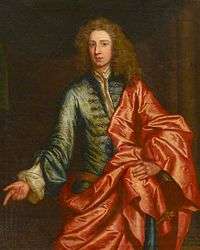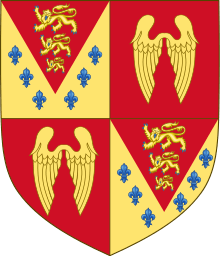Algernon Seymour, 7th Duke of Somerset


General Algernon Seymour, 7th Duke of Somerset (11 November 1684 – 7 February 1750), styled Earl of Hertford until 1748, of Petworth House in Sussex, was a British soldier, politician and landowner.
Background
Seymour was the only son of Charles Seymour, 6th Duke of Somerset, by his first wife, the heiress Lady Elizabeth Percy, deemed Baroness Percy in her own right, the only surviving child of Joceline Percy, 11th and last Earl of Northumberland.[2]
Public life
Seymour was returned to Parliament for Marlborough in 1705, a seat he held until 1708, and then represented Northumberland until 1722. From 1740 to 1750 he was Colonel of the Royal Horse Guards, then known variously as "Seymour's / Earl of Hertford's / Duke of Somerset's Regiment". He was Lord-Lieutenant of Sussex from 1706 to 1750 and Custos Rotulorum of Wiltshire from 1726 to 1750. In 1737 he was appointed Governor of Minorca, a post he held until 1742, and then served as Governor of Guernsey until 1750. In 1748 he succeeded his father in the dukedom.
Land ownership and titles
The Duke's only son Lord Beauchamp died unmarried in 1744, aged 19 (see below). In 1748 Somerset was created Baron Warkworth, of Warkworth Castle in the County of Northumberland, and Earl of Northumberland, with remainder to his son-in-law, Sir Hugh Smithson, 4th Baronet,[3] with the intention that the majority of the Percy estates should descend in this line. He was at the same time created Baron of Cockermouth, in the County of Cumberland, and Earl of Egremont, with remainder to his nephews, Sir Charles Wyndham, 4th Baronet, of Orchard Wyndham, and Percy Wyndham-O'Brien,[3] a revival of the Egremont title held by an earlier member of the Percy family, Thomas Percy, 1st Baron Egremont.
Family
In 1713, Somerset married Frances Thynne, daughter of Henry Thynne (1675–1708) and granddaughter of Thomas Thynne, 1st Viscount Weymouth. This Thomas Thynne was the first cousin of "Tom of ten thousand", who had been the second husband of Algernon's own mother, Elizabeth. Somerset and Frances had two children:
- George Seymour, Viscount Beauchamp (11 September 1725 – 11 September 1744), predeceased his father, unmarried.
- Elizabeth Percy, suo jure 2nd Baroness Percy (26 November 1716 – 5 December 1776), married Sir Hugh Smithson, 4th Baronet, later 2nd Earl of Northumberland by right of his wife and 1st Duke of Northumberland by creation; had issue.[2]
Algernon died in 1750 and was buried in the Northumberland Vault, within Westminster Abbey.[4] He was one of the richest landowners in England, but as he died with no surviving son his estates were split after his death. The ducal title passed to a distant cousin, Edward Seymour, 8th Duke of Somerset. The earldom of Northumberland and most of the traditional Percy estates passed to his daughter and her husband (see Alnwick Castle, Northumberland House and Syon House). Petworth in Sussex passed to the duke's nephew Charles Wyndham, 2nd Earl of Egremont. Later dukes of Somerset lived at Maiden Bradley, a far more modest estate than those already mentioned, and for a short while at Stover House, Teigngrace, Devon and at Berry Pomeroy, Devon.
Ancestry
References
- ↑ Debrett's Peerage, 1968, p. 1036
- 1 2 thepeerage.com Algernon Seymour, 7th Duke of Somerset
- 1 2 "No. 8887". The London Gazette. 23–26 September 1749. pp. 2–3.
- ↑ "Elizabeth, Duchess of Northumberland - Westminster Abbey". Archived from the original on 4 March 2016. Retrieved 30 September 2013.
| Parliament of England | ||
|---|---|---|
| Preceded by Edward Ashe John Jeffreys |
Member of Parliament for Marlborough 1705–1707 With: John Jeffreys |
Succeeded by Parliament of Great Britain |
| Parliament of Great Britain | ||
| Preceded by Parliament of England |
Member of Parliament for Marlborough 1707–1708 With: John Jeffreys 1707–1708 Hon. James Bruce 1708 |
Succeeded by Hon. James Bruce Sir Edward Ernle |
| Preceded by Thomas Forster Sir John Delaval, Bt |
Member of Parliament for Northumberland 1708–1722 With: Thomas Forster 1708–1716 Francis Delaval 1716–1722 |
Succeeded by Francis Delaval Sir William Middleton |
| Military offices | ||
| Preceded by Emanuel Scrope Howe |
Colonel of the Earl of Hertford's Regiment of Foot 1709–1715 |
Succeeded by Henry Harrison |
| Preceded by The Duke of Northumberland |
Captain and Colonel of The Queen's Troop of Horse Guards 1715–1740 |
Succeeded by The Duke of Marlborough |
| Preceded by Richard Kane |
Governor of Minorca 1737–1742 |
Succeeded by The Earl of Stair |
| Preceded by The Duke of Argyll |
Colonel of the Royal Horse Guards 1740–1742 |
Succeeded by The Duke of Argyll |
| Preceded by The Earl of Pomfret |
Governor of Guernsey 1742–1750 |
Succeeded by Sir John Ligonier |
| Preceded by The Duke of Argyll |
Colonel of the Royal Horse Guards 1742–1750 |
Succeeded by The Duke of Richmond |
| Honorary titles | ||
| Preceded by The Earl of Dorset |
Lord Lieutenant of Sussex 1706–1750 |
Vacant Title next held by The Earl of Ashburnham |
| Preceded by The Duke of Kingston-upon-Hull |
Custos Rotulorum of Wiltshire 1726–1750 |
Succeeded by Robert Sawyer Herbert |
| Peerage of England | ||
| Preceded by Charles Seymour |
Duke of Somerset 1748–1750 |
Succeeded by Edward Seymour |
| Earl of Hertford 1748–1750 |
Extinct | |
| Baron Beauchamp 1748–1750 | ||
| Baron Seymour of Trowbridge 1748–1750 | ||
| Peerage of Great Britain | ||
| New creation | Earl of Northumberland 1749–1750 |
Succeeded by Hugh Percy |
| Earl of Egremont 1749–1750 |
Succeeded by Charles Wyndham | |
| Baron Percy 1722–1750 |
Succeeded by Elizabeth Smithson | |